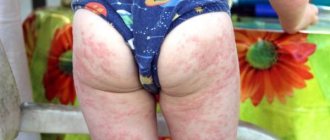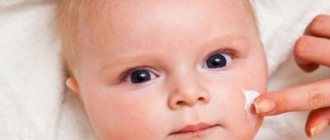- Home /
- Blog /
- About children
January 13, 2020
According to WHO, approximately 40% of the world's population has allergies in the 21st century. Humanity suffers from skin allergies, allergies to insect bites, sunlight and cold. However, the “leader” of the rating is food allergies. And most of all, it worries children - both infants and older children, as well as teenagers.
The disease only seems insignificant. She has learned to “disguise” herself as other illnesses, so not every parent is able to recognize it. We have already told you how to get rid of allergies. Today we will talk about food allergies. Why can one child eat everything without harm to health, while another completely harmless chocolate bar causes allergies?
How do food allergies manifest in children? 3 main symptoms
Food allergies manifest themselves differently in children of different ages. But parents should know the general symptoms of the disease: the child does not want anything, is capricious, sleeps poorly and anxiously at night, and suffers from lack of sleep during the day.
At the same time, the disease also has its own characteristic warning signs. Some appear more often, others less often. Let's name 3 main signs of food allergies in children.
Skin reaction
To a greater extent, food allergies in children are shown through redness. Pink dots, bubbles and red spots appear. The rash may continue with itching - this makes the child sleep and eat poorly.
Respiratory system
Food allergies in children manifest themselves in the respiratory system through a runny nose and nasal congestion, pain and sore throat, and cough. With a strong reaction, swelling appears. This is a reason to urgently call an ambulance.
Gastrointestinal tract
Allergies disrupt the functioning of the child’s stomach and intestines. The baby is worried about colic and bloating. Older children feel nauseous and vomit, and experience abdominal pain.
How to distinguish a cold from an allergy in a child
A cold goes away within 10 days at the latest, but allergies appear constantly.
Here are the obvious signs of an allergy:
- the child constantly sniffles, especially if the nasal discharge is clear and liquid, and not yellow or green and thick;
- the baby constantly sneezes, his eyes are red, wet and itchy;
- the child has dark circles under his eyes, his nose is constantly stuffy, and he breathes through his mouth;
- dry cough;
- the skin is inflamed, red and itchy.
Food allergies in children. Looking for reasons
Why do food allergies occur in children? There are several reasons for allergic reactions.
1. Immaturity of the child’s digestive system
For babies, everything is just starting to work, so it’s difficult for the body to cope with digesting proteins. Even small amounts of allergens can lead to a serious reaction.
2. Irrational introduction of complementary foods
Improper or early introduction of new foods into a baby's diet can cause allergies. Too much food can also cause an adverse reaction in the body. Therefore, everything new should be given to the baby one at a time, starting with one teaspoon.
An allergy in a baby can manifest itself due to breast milk - if the mother the day before ate a new or allergenic product. But here, too, everything is individual.
3. Heredity
Food allergies in children sometimes occur due to unfavorable heredity. Parents suffer from allergies, and not necessarily food allergies. The risk of developing this disease in a child increases significantly.
4. Ecology
Poor environmental conditions can also affect a child's allergies. These are atmospheric and air pollution, climate change, lack of greenery in cities, the emergence of unnatural food and substitute products.
5. Bad habits
The risk of allergic reactions increases the presence of bad habits. We are talking about smoking, drinking alcohol or using drugs, both by the child and the mother during pregnancy.
Possible causes of a rash in a child
10.12.2021
Scarlet fever
The rash with scarlet fever is small, like semolina , pinpointed. You often have to look closely to see it. It is located on the stomach , groin, inner thighs, and elbow bends. It appears at the beginning of the disease. But most often, high fever, vomiting, and headache are detected first. The main symptom of scarlet fever is bright red, burning tonsils in the child’s throat. Perhaps this is the most dangerous childhood infection, as it often causes complications in the heart and kidneys . At the slightest sign of scarlet fever, call a doctor . Well, if you find out that your child has been in contact with a person with scarlet fever, be on alert: observe him for 7-10 days, give him vitamins. In general, be wary throats sore throat . Not even every doctor the diphtheria film on the tonsils .
Measles
The measles rash is large and bright, immediately noticeable , and rises above the skin in the form of small papules. At first it usually appears on the face , forehead, behind the ears , and the next day it “descends” to the body, arms, and on the third day to the legs . It is preceded by a fever, a rough cough, and the eyes (pain appears). After complete rash, the temperature goes away. Parents often worry about pigmentation - don’t worry, it will go away later without a trace. This disease does not cause severe complications in vaccinated children.
Rubella
Rubella is probably the easiest infectious disease for children. The temperature is low, the throat , and the occipital lymph nodes become inflamed. The rash can be large or small and appears all over the body at once. But pregnant women should beware of rubella, as this virus causes fetal deformities.
Herpes
When the body weakens, herpes usually appears on the lips. The bubbles are usually smeared with brilliant green, cauterized with alcohol, and irradiated with quartz. From experience, I know that herpes does not like regular earwax (it can be obtained from ears ). There are expensive antiviral ointments: Verulex, Acyclovir, others usually do not help. Herpes is not so harmless. Sometimes herpetic meningoencephalitis occurs, when, against the background of a simple cold, the child suddenly loses consciousness. An attentive doctor will find herpetic blisters on the inside of the cheeks. With this disease, time is counted by the clock. Only urgent intensive therapy with special antiviral drugs will help. It is important to recognize the disease as early as possible...
Prickly heat
Miliaria is a harmless rash; small, pink, slightly raised above the skin, located on the back , neck , chest . The reason for its appearance is overheating and insufficient care. If you find heat rash in your baby, wash him, change his underwear, and make sure he doesn't sweat. This rash is not contagious, but you need to take care of the child’s skin so that purulent rashes do not appear - small yellowish blisters, vesiculopustulosis. This is a fairly serious disease, a frequent scourge of infants, and it also happens to older children. Bubbles appear on the back , chest , neck , legs , arms. They burst, leaving crusts (pustules) on the skin. From the bursting blisters, pathogens (staphylococci) enter neighboring areas of the skin, and so they spread throughout the body. This happens especially quickly when swimming. If you find such an abscess, immediately lubricate it with brilliant green.
Streptoderma
More dangerous is streptoderma, during which purulent blisters appear the mouth , body, neck , and face They quickly burst, forming purulent crusts. If the slightest signs of this disease appear, the child should not be taken to kindergarten or school. Contact a dermatologist . Streptoderma is treated with special ointments.
Allergy
Allergic rash is perhaps the most common among non-infectious diseases. This is a reaction to foods and medications. It looks like a rash from a nettle burn - red grains, accompanied by itching. Sometimes allergies can have severe reactions: a rash with vascular , swelling of the eyes , lips, face . One of the reasons for its appearance is that our market is saturated with powerful allergens : oranges, tangerines, chewing gum, drinks (containing a full range of chemical elements), chocolate. Honey and strawberries are also allergens
Many parents treat allergic rashes in their children with Diphenhydramine, Suprastin, and Tavegil. These are old drugs that have many side effects: they penetrate the central nervous system, causing lethargy, drowsiness, and “Pipalfen” even hallucinations. There are more modern drugs - Claritin, Loratadine, Gismanal, Histolong, Zyrtec, Terfenadine. I think that mothers should know about them, as they are more effective and harmless.
Often, ordinary sweets cause a rash in a child. Think about it, maybe this pleasure isn’t worth such dire consequences? After all, sometimes allergies can only be eliminated with hormones , which in themselves are dangerous for the child. When allergies , parents need to be wary, because an allergic rash is just the tip of the iceberg of trouble that is happening in the child’s body.
Published in Pediatrics Premium Clinic
Treating food allergies
How to treat food allergies in a child? There are two types of therapy - diet and medication. The treatment program for each child is individual; a pediatrician and specialized specialists - a nutritionist and an allergist - will help you choose it.
Diet
Diet is very important in treating food allergies in a child. First, it is necessary, of course, to limit the child from eating foods that cause allergic reactions. Parents should not forget that the diet should be balanced. There is no need to give up foods rich in vitamins and nutrients.
If we are talking about a breastfed child, the mother needs to think about the diet.
Complementary feeding, as we mentioned earlier, should be started gradually. If a child suffers from allergies, then doctors advise giving highly allergenic foods - cow's milk, nuts, chicken eggs - to the baby only when he is two years old.
Medicines
To relieve food allergy symptoms in children, doctors usually prescribe antihistamines and adsorbents. Creams and ointments will help get rid of redness and itching. Parents of the baby should strictly monitor the timely intake of medications and avoid overdose of the drug.
You can also recover from allergies within the walls of a sanatorium. The Mashuk Aqua-Therm sanatorium has a special children's program for Treatment of food allergies.
January 13, 2022 | allergy | children's programs
Non-food allergies
So, we are very close to the appearance of allergic reactions in infants that are not related to food. In the vast majority of cases, their cause lies in heredity and constant contact with the allergen. Most often, the body's reaction can be caused by:
- dust and dust mites;
- animal hair;
- plant pollen;
- household chemicals;
- children's cosmetics.
To find out what exactly caused the allergic reaction, the doctor performs skin tests. To do this, apply one or another suspected allergen to the baby’s skin and monitor the reaction. If after a certain time the skin has not changed, they move on to the next possible “culprit”... and so on until the allergen is identified. After all this, the mother’s task is to find a way to isolate the baby from contact with the allergen and select the optimal medicinal support.
I would like to make a separate point about the baby’s allergic reaction to diapers. In this case, the rash consists of small dots with redness, itching, and swelling, which invariably raises a lot of questions for parents. The first step is to exclude diaper dermatitis, which manifests itself with rare diaper changes, and the factor of mechanical irritation (inconvenient Velcro and elastic bands). In other cases, allergies may occur due to:
- using cheap diapers made from low-quality materials or counterfeits;
- frequent changes of brands of diapers;
- additional components in the composition of diapers (chamomile, aloe).
Get rid of allergies, pick up a healing ointment and switch to Huggies - diapers with natural 100% cotton and hypoallergenic porous materials that allow your baby's skin to breathe.
Contact dermatitis
A reaction from the immune system occurs when the skin comes into contact with a specific allergen. For a child, this could be woolen items, cosmetics, for example, ointments and creams, or chemicals used to treat the bed.
Symptoms of skin allergies, the photo of which you see below:
- redness;
- swelling;
- bubbles with liquid inside;
- Often, after scratching the blisters, secondary infection occurs and erosions may appear.
Important! There is no need to take this type of allergy with photodermatitis or sunburn. Thus, radiation damage to the skin occurs due to prolonged exposure to direct rays.
Causes and symptoms of drug allergies
The features of drug allergies include, first of all, a sudden attack-like onset, often with severe general symptoms; in some cases, a febrile reaction is observed.
A feature of skin manifestations in drug allergies is polymorphism, that is, the rashes can be spotty, blistered, nodular, etc. Skin manifestations can be complicated by the development of purulent processes.
Acute urticaria and angioedema are the most common manifestations of drug allergies, which, by the way, can be either the only symptoms of drug allergies or combined with other allergic reactions.
Penicillin is most often the cause of drug-induced urticaria. During the first course of penicillin therapy, urticaria may occur 5-6 days, or maybe 20-50 days after the start of antibiotic treatment. But with a second course of penicillin therapy, rashes usually appear immediately after administration of the drug. In this case, acute drug-induced urticaria can take a chronic course even after stopping further use of penicillin. The reason for its development can also be the consumption of foods containing even a minimal amount of antibiotic.
Erythema nodosum may also occur as a result of taking medications. It appears in the thickness of the skin of the extensor surfaces of the legs, less often on the thighs and forearms. They are symmetrically located, painful when palpated, dense hemispherical nodes up to several centimeters in diameter. The color of the skin over the nodes is initially bright red, later changing to bluish or greenish-yellow. The cause of the development of erythema nodosum is most often sulfonamide drugs. The disease usually develops within 1-2 weeks of treatment with these drugs. With repeated administration of sulfonamides, erythema nodosum recurs.
Make an appointment
The field of immunology - allergology is dynamic and constantly evolving - we are aware of the latest developments, and are among the first to introduce new treatment methods. Our own centralized clinical diagnostic laboratory allows us to obtain tests much faster with a minimal percentage of errors caused by human factors.
In the allergology departments of the clinics, consultations are conducted by specialists with 15 years of experience, candidates, doctors of medical sciences. Doctors take part in symposia and conferences, participate in clinical trials of new drugs, and are members of the European Society of Primary Immunodeficiencies. We provide emergency assistance, including cases of overdose.
The clinic offers a full range of tests, anti-shock measures, hospitalization with symptomatic and infusion therapy. Our branches are conveniently located and operate year-round without weekends or queues. To register, use the form on the website or call us. Doctors will tell you how to treat drug allergies correctly, even in difficult cases.
Symptoms and signs
Diagnosing and prescribing treatment for childhood allergies is often a real quest for specialists, because the manifestations of allergic diseases in children are diverse, and they often “hide” under other diseases or occur simultaneously with them. For example, diagnosing allergic enteropathy is difficult, since it is easily disguised as the manifestation of other diseases, for example, colic or dyspepsia. However, there are the most common manifestations of the disease, which make it possible to more accurately determine their cause.
For example, symptoms of rhinitis (nasal congestion, sneezing, runny nose) indicate a respiratory (respiratory) allergy in response to the entry of an allergen into the mucous membrane of the respiratory tract. In more severe cases, respiratory allergies are accompanied by a dry, obsessive cough, shortness of breath, and wheezing. And bronchial asthma becomes a kind of “peak”.1,3,4
Skin rashes on the cheeks, elbows and knees, behind the ears, around the eyes and wings of the nose, on the buttocks signal allergic dermatitis, which in children is often provoked by food, cold and drug allergies.1,4
If the child's eyelids are red, tears are flowing profusely (while he is in his usual mood), there is mucus in the corners of the eyes, and the eyes are itching - all this may be a consequence of allergic conjunctivitis.
But the most dangerous symptoms are anaphylactic shock, an immediate allergic reaction that requires urgent medical attention. These include pallor, sticky cold sweat, shortness of breath, spasms or twitching of certain parts of the body, involuntary urination and defecation, loss of consciousness, rare breathing, and a decrease in heart rate.1,4
How long does it take for an allergic rash to go away?
Patients who have discovered an allergic rash are interested in how long it takes for the symptoms to go away, and is it possible to be cured completely? Doctors say that it is difficult to completely get rid of a predisposition to sensitization, especially hereditary ones. You need to follow a diet for a long time, record all possible irritants and eliminate them.
How quickly the symptoms of the rash disappear depends on following the recommendations. Patients undergoing treatment for the underlying disease, taking medications prescribed by a doctor and strengthening the immune system, get rid of skin itching and allergies faster. Treatment takes at least 1-3 months, after which it is possible to achieve stable remission.
The dangers of childhood allergies
Any type of allergy is equally dangerous for infants. The health consequences can be unpredictable and very serious:
- excessive anxiety, restless sleep and crying of the child due to a skin rash accompanied by itching;
- lack of weight gain due to frequent and profuse regurgitation;
- sharp and sudden deterioration of the condition (even life-threatening) after taking an allergen product, using children's cosmetics or an insect bite;
- breathing problems (due to swelling and spasm of the airways);
Diagnostic methods
If you suspect an allergy, you should contact your pediatrician, who, after conducting an initial examination, will refer the child to an allergist. And already there the doctor will prescribe all the necessary procedures that will help to understand exactly what kind of allergic reaction the child has and what it is. These include skin tests and blood tests for general and specific IgE. As well as provocative tests with the application of a drug with an allergen to the mucous membrane of the eyes, nose, respiratory tract, orally. Naturally, this study is carried out only under the supervision of a doctor.1,4
Kinds
- Allergic dermatitis
Skin manifestations, which most often affect exposed parts of the body that come into contact with care products or diapers.
- Allergic conjunctivitis
Develops due to sensitization to flowering plants, waste products of pets, due to food allergies.
- Allergic enteropathy
Drug or food intolerance with symptoms such as abdominal pain, prolonged and severe attacks of colic.
- Hay fever, hay fever
Annual exacerbation of allergies associated with flowering or ripening of plants.
- Allergy to ultraviolet light
Manifests itself in the form of urticaria, itching and pain.
- Urticaria or urticaria rash
The name accurately reflects the nature of the reaction: it is similar to nettle burns or multiple insect bites.
- Allergic rhinitis
A reaction to food and household allergens, but the main provocateur of seasonal rhinitis is flowering and dusting of trees and plants.
- Drug allergy
Develops in response to the introduction of medications into the body.
- Cold allergy
An allergic reaction to low air temperature, manifested in the form of difficulty breathing, swelling of the mucous membranes of the nose and eyes, and redness of the skin.
- Quincke's edema
An acute allergic reaction that requires emergency medical attention. It is observed in case of food or drug allergies, insect bites or after contact with an animal.1,2,3,4









